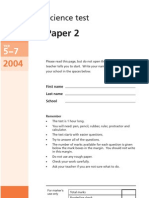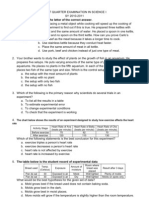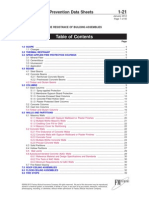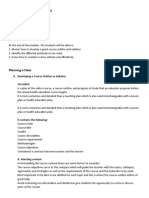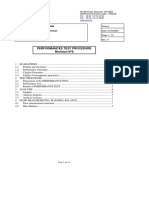Lawson Test Sopiah
Lawson Test Sopiah
Uploaded by
Jj AitengCopyright:
Available Formats
Lawson Test Sopiah
Lawson Test Sopiah
Uploaded by
Jj AitengCopyright
Available Formats
Share this document
Did you find this document useful?
Is this content inappropriate?
Copyright:
Available Formats
Lawson Test Sopiah
Lawson Test Sopiah
Uploaded by
Jj AitengCopyright:
Available Formats
APPENDIX A
CLASSROOM TEST OF SCIENTIFIC REASONING (CTSR)
Table A(1): Breakdown of thinking skills for CTSR test
Thinking patterns
Conservation of i) weight and ii) volume Proportional thinking Identification and control of variables Probabilistic thinking Correlational thinking Combinatorial thinking
TOTAL
Item (CTSR- Post-Test)
1 2 3,4 5, 6 7,8 9, 10 11 , 12 12
CLASSROOM TEST OF SCIENTIFIC REASONING
1. Suppose you are given two clay balls of equal size and shape. The two clay balls also weigh the same. One ball is flattened into a pancake-shaped piece. Which of these statements is correct? A. The pancake-shaped piece weighs more than the ball. B. The two pieces still weigh the same. C. The ball weighs more than the pancake-shaped piece.
BECAUSE 1. the flattened piece covers a large area. 2. the ball pushes down more on one spot. 3. when something is flattened it loses weight. 4. clay has not been added or taken away. 5. when something is flattened it gains weigh.
2. Figure A shows two cylinders filled to the same level with water. The cylinders are identical in size and shape. Also shown in Figure A are two marbles, one glass and one steel. The marbles are the same size but the steel one is much heavier than the glass one.
Glass marble
Steel marble
Cylinder 1
Cylinder 2
FIGURE A When the glass marble is put into Cylinder 1, it sinks to the bottom and the water level rises to the 6 th mark. If we put the steel marble into cylinder 2, the water will rise A. To the same level as it did in Cylinder 1 B. To a higher level than it did in Cylinder 1 C. To a lower level than it did in Cylinder 1
BECAUSE 1. 2. 3. 4. 5. the steel marble will sink faster. the marbles are made of different materilas. the steel marble is heavier than the glass marble. the glass marble creates less pressure. the marbles are the same size.
3. Figure B(i) shows a wide and a narrow cylinder. The cylinders have equally spaced marks on them. Water is poured into the wide cylinder up to the 4th mark (see Figure B(i)). This water rises to the 6th mark when poured into the narrow cylinder (see Figure B(ii)).
4th mark FIGURE B (i) FIGURE B (ii)
6th mark
Both cylinders are emptied (not shown) and water is poured into the wide cylinder up to the 6th mark. How high would this water rise if it were poured into the empty narrow cylinder? A. B. C. D. E. To about 8. To about 9. To about 10. To about 12. None of these answers is correct.
BECAUSE 1. 2. 3. 4. 5. the answer can not be determined with the information given. it went up 2 more before, so it will go up 2 more again. it goes up 3 in the narrow for every 2 in the wide. the second cylinder is narrower. one must actually pour the water and observe to find out.
4. Water is now poured into the narrow cylinder (described in item 3 above) up to the 11th mark. How high would this water rise if it were poured into the empty wide cylinder? A. To about 7 B. To about 9 C. To about 8 D. To about 7 1/3 E. None of these answers is correct. BECAUSE 1. the ratios must stay the same. 2. One must actually pour the water and observe to find out. 3. the answer can not be determined with the information given. 4. it was 2 less before so it will be 2 less again. 5. you subtract 2 from the wide for every 3 from the narrow. 5. Figure C shows 3 strings hanging from a bar. The three strings have metal weights attached to their ends. String 1 dan string 3 are the same length. String 2 is shorter. A 10 unit weight is attached to the end of string 1. A 10 unit weight is also attached to the end of string 2. A 5 unit weight is attached to the end of String 3. The Strings (and attached weights) can be swung back and forth and the time it takes to make a swing can be timed.
FIGURE C
Suppose you want to find out whether the length of the string has an effect on the time it takes to swing back and forth. Which strings would you use to find out? A. B. C. D. E. Only one string All three strings 2 and 3 1 and 3 1 and 2
BECAUSE 1. you must use the longest strings.
2. you must compare strings with both light and heavy weights. 3. only the lengths differ. 4. 5. to make all possible comparisons the weights differ.
6.
In a second experiment, suppose you wanted to find out whether the amout of weight
attached to the end of a string has an effect on the time it takes for a string to swing back and forth. Which of the strings would you use to find out? A. string 1 dan 2 B. string 1 dan 3 C. string 2 dan 3 D. string 1, 2 dan 3 E. string 3 saja
BECAUSE: 1. The weights should be same, the length of the strings should be different. 2. the length of the strings should be same, the weights should be different, so you can tell if weights make a difference.
3. Different lengths with different weights should be tested. 4. All strings and their weights should be tested against all others. 5. only the smallest weights should be tested.
7.
Six square pieces of wood are put into a cloth bag and mixed about. The six pieces are identical in size and shape, however, three pieces are red (labeled M) and three are yellow (labeled K) as shown in Figure D. M M M K FIGURE D Suppose someone reaches into the bag (without looking) and pulls out one piece. What are the chances that the piece is red? A. B. C. D. E. 1 chance out of 6 1 chance out of 3 1 chance out of 2 1 chance out of 1 can not be determined K K
BECAUSE: 1. 2. 3. 4. 5. 3 out of 6 pieces are red. there is no way to tell which piece will be picked. only 1 piece of the 6 in the bag is picked. all 6 pieces are identical in size and shape. only 1 red piece can be picked out of the 3 red pieces.
8.
In a second experiment, 3 red square pieces of wood, 4 yellow square pieces, and 5 blue square pieces are put into a cloth bag. 4 red round pieces, two yellow round pieces, and three blue round pieces are also put into the bag. All the pieces are then mixed about.
M K B
M K B
M K B K B B
FIGURE E Suppose someone reaches into the bag (without looking and without feeling for a particular shape piece) and pulls out one piece (Figure E). What are the chances that the piece is red round or blue round piece? A. Can not be determined B. 1 chance out of 3 C. 1 chance out of 21 D. 15 chances out of 21 E. 1 chance out of 2 BECAUSE: 1. 1 of the 2 shapes is round. 2. 15 of the 21 pieces are red or blue. 3. there is no way to tell which piece will be picked. 4. only 1 of the 21 pieces is picked out of the bag. 5. 1 of every 3 pieces is a red or blue round piece.
9.
Pak Abu was observing the mice that live in his field. He discovered that all of them were either fat or thin. Also, all of them had either black tails or white tails. This made him wonder if there might be a link between the size of the mice and the color of their tails. So he captured all of the mice in one part of his field and observed them. Below are the mice that he captured (Figure F).
FIGURE F Do you think there is a link between the size of the mice and the color of their tails? A. B. C. Appears to be a link Appears not to be a link Can not make a reasonable guess.
BECAUSE: 1. 2. 3. 4. 5. there are some of each kind of mouse. there may be a genetic link between mouse size and tail color. there were not enough mice captured. most of the fat mice have black tails while most of the thin mice have white tails. as the mice grew fatter, their tails become darker.
10. The fish in the drawing (Figure G) were caught by a fisherman, who noticed that some of the fish were big and some were small. Also some had wide stripes, and others had narrow stripes. This made the fisherman wonder if there was a relation between the size of the fish and the width of their stripes.
FIGURE G Do you think there is a relation between the size of the fish and the width of their stripes? A. B. Yes No
BECAUSE: 1. Big fish and small fish can have either wide or narrow strips. 2. 3/7 of the big fish and 9/21 of the small fish have wide strips. 3. 7 of the fish are big and 21 are small. 4. Not all big fish have wide strips and not all small fish have narrow strips. 5. 12/28 of the fish have wide strips and 16/28 of the fish have narrow strips.
11. A cook wanted to prepare lunch for his owner. There are 3 kinds of meat: chicken (C), beef (B) and mutton (M), and 3 kinds of vegetables: kailan (K), long beans (L) and ladys fingers (F). One possible combination is chicken-kailan (C-K). List all other possible ways that the lunch consists of one meat and one vegetable. C K,
12. Three students from Form Three, Form Four, and Form Five were elected to the student council as listed in Table 1. STUDENT COUNCIL Form 4 Form 5 Jais (J) Daniel (D) Anita (A) Martina (M) Chong (C) Goh (G) TABLE 1 A three member committee is to be formed with one person from each grade. All possible combinations must be considered before a decision can be made. Two possible combinations are Thomas, Jais and Daniel (TJD), and Samiah, Chong and Daniel (SCD). List all other possible combinations in the spaces provided. TJD, SCD,
Form 3 Thomas (T) Samiah (S) Kassim (K)
You might also like
- Multiple Choices: Fill The Circle On The Answer Sheet With The Right AnswerDocument9 pagesMultiple Choices: Fill The Circle On The Answer Sheet With The Right Answergonovu100% (2)
- ASSET Practice Questions Class 5 Set-1Document9 pagesASSET Practice Questions Class 5 Set-1DHRITI GUPTA80% (5)
- KS3 Science 2009 T5-7 Paper 2Document28 pagesKS3 Science 2009 T5-7 Paper 2박찬우No ratings yet
- Assignment 2 - Unit PlanDocument26 pagesAssignment 2 - Unit Planapi-525100578No ratings yet
- Scientific Reasoning TestDocument10 pagesScientific Reasoning TestNur AsilahNo ratings yet
- General Mock Test 02Document31 pagesGeneral Mock Test 02Agron, Alliah Yasmine R.No ratings yet
- Sample QuestionDocument2 pagesSample QuestionBudiSutrisno83% (12)
- Paper 2Document32 pagesPaper 2naamashirNo ratings yet
- Preparation TournamentDocument7 pagesPreparation TournamentEddy R. VélezNo ratings yet
- S1 Is YE Term Exam 2022 - Final VersionDocument19 pagesS1 Is YE Term Exam 2022 - Final VersionTimmy SzeNo ratings yet
- TQ Q4 Mathematics 6 - Jane RamosDocument10 pagesTQ Q4 Mathematics 6 - Jane RamosPoncianaNo ratings yet
- 奥数模块分析考试试卷及答案Document12 pages奥数模块分析考试试卷及答案Dong Yuwen (Nhps)No ratings yet
- Science 2003 P1 T36Document40 pagesScience 2003 P1 T36Sarva NanthanNo ratings yet
- 9999064582Document32 pages9999064582naamashirNo ratings yet
- APSU Practice Test 2018 - Grade7Document8 pagesAPSU Practice Test 2018 - Grade7Ma. Oliva Diana CastroNo ratings yet
- First Periodic Test Science I Sy 2010-2011-1Document7 pagesFirst Periodic Test Science I Sy 2010-2011-1Myra Jamindang Tamayo33% (3)
- Ece Math ProblemsDocument8 pagesEce Math ProblemsDanika JanNo ratings yet
- PT - Mathematics 6 - Q4 - V2Document7 pagesPT - Mathematics 6 - Q4 - V2RusherNo ratings yet
- Maths Sample Paper 7Document4 pagesMaths Sample Paper 7Suman DesarkerNo ratings yet
- Science Revision Worksheets Solution Term 1grade 6Document12 pagesScience Revision Worksheets Solution Term 1grade 6ar.ultimate99No ratings yet
- Paper 2: Mathematics TestDocument24 pagesPaper 2: Mathematics TestMingNo ratings yet
- 2002 GR 0708Document4 pages2002 GR 0708Pei JingNo ratings yet
- Fourth Quarterly Test in Mathematics 6 S.Y. 2017-2018Document5 pagesFourth Quarterly Test in Mathematics 6 S.Y. 2017-2018Mary Jane Climaco GamoseNo ratings yet
- MathDocument7 pagesMathSakamotoMedan ellen tan100% (3)
- Prepare Final Exam Grade 9Document7 pagesPrepare Final Exam Grade 9Iffah YusrifaniNo ratings yet
- ISMC 2016 Primary 4 QuestionsDocument8 pagesISMC 2016 Primary 4 QuestionsAileen Mimery100% (1)
- WWW - Emaths.co - Uk - SAT PAPERS - KS3 SAT Papers - Science KS3 SAT Papers - Science SATs 2009 - 36P1Document32 pagesWWW - Emaths.co - Uk - SAT PAPERS - KS3 SAT Papers - Science KS3 SAT Papers - Science SATs 2009 - 36P1Jeanette WhiteleggNo ratings yet
- Jawapan Soalan Latihan Sains Tahun 4, 5, 6Document27 pagesJawapan Soalan Latihan Sains Tahun 4, 5, 6FT Geeyah TahirNo ratings yet
- Fourth Quarterly Test in Mathematics 6Document4 pagesFourth Quarterly Test in Mathematics 6Hazel GangcaNo ratings yet
- Exercises ADocument21 pagesExercises AJuveylyn CabacheteNo ratings yet
- Napolcom 2021 Quantitative ReasoningDocument6 pagesNapolcom 2021 Quantitative ReasoningprincesslykadeguzmanNo ratings yet
- Physics Labs and PDsDocument33 pagesPhysics Labs and PDsBrihanna MontaqueNo ratings yet
- Worksheet Challenging Problems On Similar Shapes Similar Triangles and Pythagoras TheoremDocument9 pagesWorksheet Challenging Problems On Similar Shapes Similar Triangles and Pythagoras TheoremTazreef AliNo ratings yet
- Question 2013 Set - 5 - Tcs - 2013 - Pattern - NewDocument12 pagesQuestion 2013 Set - 5 - Tcs - 2013 - Pattern - NewepynicNo ratings yet
- Net Che QSDocument33 pagesNet Che QSgajendran bNo ratings yet
- Math ViDocument5 pagesMath VicatherinerenanteNo ratings yet
- Teste MatematicăDocument11 pagesTeste MatematicăMatei N.No ratings yet
- IMOYA 2017 Middle PrimaryDocument4 pagesIMOYA 2017 Middle PrimaryFajarSalami83% (6)
- Q4 Summative Test MathDocument3 pagesQ4 Summative Test MathAnabel Cubio-Rubia100% (2)
- Table of Spec. Math 6 Quiz No.1Document8 pagesTable of Spec. Math 6 Quiz No.1joycelyn juradoNo ratings yet
- BabiDocument136 pagesBabiChong Yung FooNo ratings yet
- p1, p2 c1. General PhysicsDocument40 pagesp1, p2 c1. General PhysicsJamal RidzuanNo ratings yet
- Secondary 2 Imocsea NR TestDocument8 pagesSecondary 2 Imocsea NR Testinyoman.augustiniNo ratings yet
- Test 1 Form A Solutions PDFDocument17 pagesTest 1 Form A Solutions PDFEmmett GeorgeNo ratings yet
- 23 SeptDocument8 pages23 SeptCYNTHIA TING XING ROU MoeNo ratings yet
- Bài D y Ngày 2-3Document12 pagesBài D y Ngày 2-3Huỳnh Minh MẫnNo ratings yet
- Tutorial - Problem SolvingDocument28 pagesTutorial - Problem Solving阳兄 シNo ratings yet
- Class 07 Test 02Document4 pagesClass 07 Test 02Intro MakerNo ratings yet
- Year9 Science Final Pre Test Set BDocument10 pagesYear9 Science Final Pre Test Set BYoon Myat EaimNo ratings yet
- AptitudeDocument4 pagesAptitudeJanani ShreeNo ratings yet
- Science Process Skills Examination 1ncv0kyDocument9 pagesScience Process Skills Examination 1ncv0kyInsar Damopolii Tempoesekarang100% (1)
- Form2 BiologyDocument12 pagesForm2 Biologysharonofentse829No ratings yet
- Ks3 Science Paper 57P2 2008Document28 pagesKs3 Science Paper 57P2 2008odysseym1No ratings yet
- ASSET Practice Paper 1 Gr7Document13 pagesASSET Practice Paper 1 Gr7sofiyafatimasofiyafatima32No ratings yet
- Math Practice ModuleDocument26 pagesMath Practice ModuleLynel Arianne Tabor100% (1)
- Reasoning Fot PAT4Document9 pagesReasoning Fot PAT4Jeevan KaturiNo ratings yet
- UKMT - Grey Kangaroo - Intermediate Mathematical Challenge 2017 - QuestionsDocument4 pagesUKMT - Grey Kangaroo - Intermediate Mathematical Challenge 2017 - QuestionsMary Jean Agudilla CaringalNo ratings yet
- O Level Biology Practice Questions And Answers Transport In PlantsFrom EverandO Level Biology Practice Questions And Answers Transport In PlantsNo ratings yet
- Knitted Animal Nursery: 37 gorgeous animal-themed knits for babies, toddlers, and the homeFrom EverandKnitted Animal Nursery: 37 gorgeous animal-themed knits for babies, toddlers, and the homeNo ratings yet
- Stage/Time Content Activities Teaching and Learning Strategies Notes 1) 1)Document2 pagesStage/Time Content Activities Teaching and Learning Strategies Notes 1) 1)Jj AitengNo ratings yet
- Comprehension (Pets)Document2 pagesComprehension (Pets)Jj AitengNo ratings yet
- Participants - Instruments - Procedures - Data Analysis - LimitationsDocument2 pagesParticipants - Instruments - Procedures - Data Analysis - LimitationsJj AitengNo ratings yet
- Subject Class Time Focus Theme / Topic Learning Standards ObjectivesDocument1 pageSubject Class Time Focus Theme / Topic Learning Standards ObjectivesJj AitengNo ratings yet
- Policies and Procedures SampleDocument4 pagesPolicies and Procedures SampleJj AitengNo ratings yet
- Name: Class: - : Year 1 (Semester 1 / 2014) English Language Summative AssessmentDocument6 pagesName: Class: - : Year 1 (Semester 1 / 2014) English Language Summative AssessmentJj AitengNo ratings yet
- Format Set InduksiDocument2 pagesFormat Set InduksiJj AitengNo ratings yet
- Cheong Fatt Tze Mansion City Hall, EsplanadeDocument5 pagesCheong Fatt Tze Mansion City Hall, EsplanadeJj AitengNo ratings yet
- Farm Animals Lesson PlanDocument5 pagesFarm Animals Lesson PlanJj AitengNo ratings yet
- How Can I - ? What Would I I Propose That Ihaveagoalto StoryDocument1 pageHow Can I - ? What Would I I Propose That Ihaveagoalto StoryJj AitengNo ratings yet
- Dcyber Daily Sales 1borneo For August 2013: Week 1 Week 2 Week 3 Week 4 Week 5 5040 6314 4368 4359 512Document2 pagesDcyber Daily Sales 1borneo For August 2013: Week 1 Week 2 Week 3 Week 4 Week 5 5040 6314 4368 4359 512Jj AitengNo ratings yet
- Letter of AuthorizationDocument2 pagesLetter of AuthorizationJj Aiteng100% (1)
- Discovery Method: Lim Ai Teng MD Haidin Bin RubinDocument13 pagesDiscovery Method: Lim Ai Teng MD Haidin Bin RubinJj AitengNo ratings yet
- Gurney Drive Hawker CenterDocument1 pageGurney Drive Hawker CenterJj AitengNo ratings yet
- Adjustable Fraction RulerDocument1 pageAdjustable Fraction RulerJj AitengNo ratings yet
- Thinking Out of The Box But Working AlongDocument22 pagesThinking Out of The Box But Working AlongJj AitengNo ratings yet
- Correlation and RegressionDocument61 pagesCorrelation and RegressionPragya MehraNo ratings yet
- Week 3 Tema 41 Octubre 2020Document12 pagesWeek 3 Tema 41 Octubre 2020ismael palmaNo ratings yet
- 36 - (Systems) (9) Saw Tooth Structures (2016)Document232 pages36 - (Systems) (9) Saw Tooth Structures (2016)shakerxxooNo ratings yet
- 1 65265 Ccvs1 - Vecu-F 0x18FEF121 2 65265 Ccvs1 - Vecu-F 0x18FEF121 3 4 5 6 7 8 9 10 11 12 13 14 15 16 17 18 19 20 21 22 23 24 25 26Document16 pages1 65265 Ccvs1 - Vecu-F 0x18FEF121 2 65265 Ccvs1 - Vecu-F 0x18FEF121 3 4 5 6 7 8 9 10 11 12 13 14 15 16 17 18 19 20 21 22 23 24 25 26Prashant TambeNo ratings yet
- Diagnostics and Measurements PDFDocument64 pagesDiagnostics and Measurements PDFMartin NilssonNo ratings yet
- ITIL - An Example Emergency CM Procedure PDFDocument7 pagesITIL - An Example Emergency CM Procedure PDFRicardo Adrian FedericoNo ratings yet
- RAMIREZ, JOHN DAVE O - (Ass1 - Virtues and Values of An Architect - Module1) .Document2 pagesRAMIREZ, JOHN DAVE O - (Ass1 - Virtues and Values of An Architect - Module1) .JOHN DAVE RAMIREZNo ratings yet
- Bonding PowerpointDocument14 pagesBonding Powerpointᴍɪᴋᴋɪᴋᴀᴢᴇ100% (3)
- Internship ReportDocument7 pagesInternship ReportSouvik PanjaNo ratings yet
- FMDS0121 Fire Resistance of Building AssembliesDocument50 pagesFMDS0121 Fire Resistance of Building Assembliespamela552fq4859100% (1)
- Prevent Overheating: Configurable TDPDocument4 pagesPrevent Overheating: Configurable TDPMadhuraNo ratings yet
- Bataan Heroes College: Task No. 2: InfographicsDocument3 pagesBataan Heroes College: Task No. 2: InfographicsDarilyn Anne CastroNo ratings yet
- WDG 12 - Technical Data Sheet LV 804 TDocument8 pagesWDG 12 - Technical Data Sheet LV 804 T3efooNo ratings yet
- Types of Rear AxleDocument3 pagesTypes of Rear AxleShashank Chheniya100% (4)
- Skimming ScanninnDocument8 pagesSkimming ScanninnArmando GutierresNo ratings yet
- A.C.L.R #7Document9 pagesA.C.L.R #7Edan AdgerNo ratings yet
- Planning and Conducting ClassesDocument8 pagesPlanning and Conducting ClassesJezka Lhyn BelenNo ratings yet
- S&C 115 KV LBSDocument9 pagesS&C 115 KV LBSสมชาย ภูพงศ์ไพบูลย์No ratings yet
- Analysis On Mechanical Integrity of Hybrid Tig MigDocument4 pagesAnalysis On Mechanical Integrity of Hybrid Tig MigKaushik SenguptaNo ratings yet
- Lps Prayer ManualDocument36 pagesLps Prayer ManualSureen NarangNo ratings yet
- Grade 11 - Ict Recitation 2021-2022 1ST QuarterDocument49 pagesGrade 11 - Ict Recitation 2021-2022 1ST QuarterJandro KareemNo ratings yet
- Tik Time BombDocument2 pagesTik Time BombDewaldt HuysamenNo ratings yet
- Processing of Aerospace Materials - I (ME772) : Fracture Toughness and High Cycle Fatigue Date: 11 January 2022Document23 pagesProcessing of Aerospace Materials - I (ME772) : Fracture Toughness and High Cycle Fatigue Date: 11 January 2022B RITHIKANo ratings yet
- Master of Business Administration: A Mini Project On "Topic Name"Document6 pagesMaster of Business Administration: A Mini Project On "Topic Name"Ankit PalNo ratings yet
- Introduction To Big DataDocument11 pagesIntroduction To Big DataJitendra DangraNo ratings yet
- Desiro MainlineDocument4 pagesDesiro MainlineRodrigo SampaioNo ratings yet
- Ethics Module 1Document13 pagesEthics Module 1Shean BucayNo ratings yet
- Ife Sample Ipd ReportDocument2 pagesIfe Sample Ipd ReportCFDReseach LabNo ratings yet
- Rangkuman Musim Dan CuacaDocument6 pagesRangkuman Musim Dan CuacaZahro MufidNo ratings yet
- RFCCDocument13 pagesRFCCDuy DangNo ratings yet







